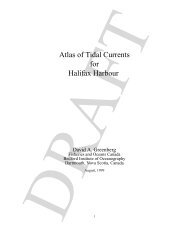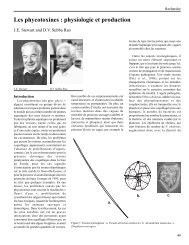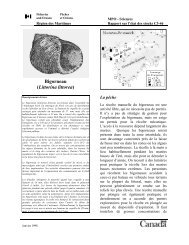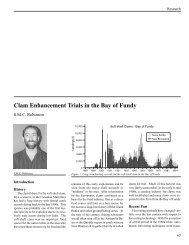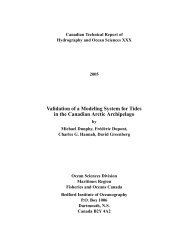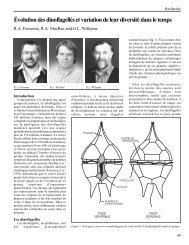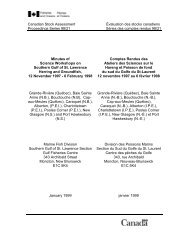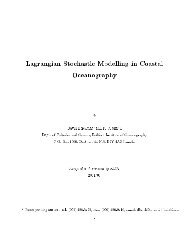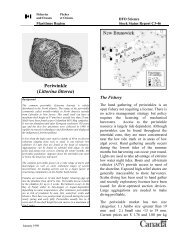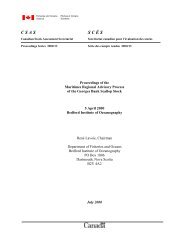bedford institute of oceanography 2001 in review - Région des ...
bedford institute of oceanography 2001 in review - Région des ...
bedford institute of oceanography 2001 in review - Région des ...
You also want an ePaper? Increase the reach of your titles
YUMPU automatically turns print PDFs into web optimized ePapers that Google loves.
SCIENCE ACTIVITIES / Ocean Sciencesdeeper. It plays a critical role <strong>in</strong> the uptake and long-term sequestration<strong>of</strong> anthropogenic CO 2 .Less well known is the role <strong>of</strong> deep convective areas such as theLabrador Sea <strong>in</strong> the sequestration <strong>of</strong> CO 2 through the biologicalpump. The biological pump is the transfer <strong>of</strong> carbon from thesurface to the deep ocean through biological processes. It beg<strong>in</strong>swith the production <strong>of</strong> organic carbon from dissolved CO 2 throughphotosynthesis. A fraction <strong>of</strong> that organic material escapes theocean’s surface, effectively remov<strong>in</strong>g CO 2 from the atmosphereoceansystem. In most <strong>of</strong> the world’s oceans, this export <strong>of</strong> organiccarbon is due mostly to the settl<strong>in</strong>g <strong>of</strong> detritus (s<strong>in</strong>k<strong>in</strong>g flux) and, toa lesser extent, to the vertical motions <strong>of</strong> mar<strong>in</strong>e biota (verticalmigration flux). Thus, <strong>in</strong> most <strong>of</strong> the world’s oceans, organic carbonmoves through the water column to reach the depths. In convectiveareas, however, such as the Labrador Sea, dissolved organic carbon(DOC) can be transported with the water to the depths where it canbe sequestered. A collaborative project with Memorial University <strong>in</strong>Newfoundland was formed to explore the strength <strong>of</strong> this DOC fluxrelative to other export fluxes and its sensitivity to climate us<strong>in</strong>gecosystem models and physical <strong>in</strong>formation on the climate <strong>of</strong> theLabrador Sea.The project uses an ecosystem model that simulates the flows <strong>of</strong>nitrogen among various ecosystem compartments and tracks thevertical motions <strong>of</strong> organic nitrogen. Nitrogen is used because it isassumed to limit biological activity <strong>in</strong> the ocean. The associatedcarbon flows are calculated us<strong>in</strong>g mostly fixed ratios. In some cases,we <strong>in</strong>troduce simple rules that essentially say that organisms prefer toreta<strong>in</strong> nitrogen <strong>in</strong> their bodies, because it is <strong>in</strong> short supply, and expelcarbon. This model has been tested extensively <strong>in</strong> the Gulf <strong>of</strong> St.Lawrence. When applied to the Labrador Sea, the model suggests thatthe DOC flux is as large as the s<strong>in</strong>k<strong>in</strong>g flux and is substantially largerthan the vertical migration flux (Figure 1). The model also suggeststhat the DOC flux is particularly efficient <strong>in</strong> mov<strong>in</strong>g organic carbonto depth, while reta<strong>in</strong><strong>in</strong>g nitrogen <strong>in</strong> the surface ocean. This decoupl<strong>in</strong>g<strong>of</strong> carbon and nitrogen fluxes enhances the biological pumpwhen nutrients are limit<strong>in</strong>g.We also exam<strong>in</strong>ed the impact <strong>of</strong> variations <strong>in</strong> the strength <strong>of</strong>w<strong>in</strong>ter convection on carbon export (Figure 2). To study this effect,the ecosystem model was forced with data on the physical structureand climate <strong>of</strong> the Labrador Sea from periods when convection wasweak (the late 1960s and early 1970s) and when it was strong (early tomid-1990s). The results <strong>in</strong>dicate that the s<strong>in</strong>k<strong>in</strong>g flux is relatively<strong>in</strong>sensitive to the variations <strong>in</strong> ocean climate. In contrast, the DOCflux is very sensitive and is the ma<strong>in</strong> contributor to climate-relatedvariations <strong>in</strong> total export. This goes aga<strong>in</strong>st prevail<strong>in</strong>g views that thes<strong>in</strong>k<strong>in</strong>g flux is the ma<strong>in</strong> driver beh<strong>in</strong>d export variability. More to thepo<strong>in</strong>t, this gives clues as to the potential impact <strong>of</strong> climate change onorganic carbon cycl<strong>in</strong>g <strong>in</strong> the Labrador Sea if climate warm<strong>in</strong>g doesresult <strong>in</strong> a reduction <strong>of</strong> w<strong>in</strong>ter convection. Lower organic carbonexport would leave more CO 2 <strong>in</strong> surface waters and lower the ocean’suptake <strong>of</strong> CO 2 .Relative change(100 is average convection)<strong>2001</strong>50100500ShallowAverage DeepMigrationS<strong>in</strong>k<strong>in</strong>gDOMExportFigure 2. Relative changes <strong>in</strong> export fluxes simulated by the physical-ecosystemmodel under shallow (< 200 m), average (300-1000 m) and deep (> 1500 m)maximum depth <strong>of</strong> w<strong>in</strong>ter convection <strong>in</strong> the central Labrador Sea.Figure 1. Relative importance <strong>of</strong> export fluxes <strong>in</strong> the Labrador Sea simulated by aphysical-ecosystem model. C export is the total downward organic carbon fluxacross the 200 m isobath (moles C/yr). C:N export is the carbon-to-nitrogen ratio <strong>of</strong>the exported organic matter (moles C/moles N); a C:N higher than 6.6, the averageC:N <strong>of</strong> organic matter, <strong>in</strong>dicates that C is preferentially exported. C export and C:Nexport averaged across a number <strong>of</strong> simulations are given at the top <strong>of</strong> each barand are broken down <strong>in</strong>to contributions from dissolved organic matter (DOM),particle s<strong>in</strong>k<strong>in</strong>g, and vertical migration.These results are prelim<strong>in</strong>ary and subject to change as the workevolves. Nevertheless, they are stimulat<strong>in</strong>g further research. Oneongo<strong>in</strong>g effort is to develop and ref<strong>in</strong>e an ecosystem model thatcouples carbon and nitrogen flows across all compartments, asopposed to only some <strong>of</strong> the compartments <strong>in</strong> this model. A relatedeffort is to <strong>in</strong>vestigate the implications <strong>of</strong> the DOC flux for climatevariations at a global scale by coupl<strong>in</strong>g the improved ecosystemmodel to an atmosphere-ocean climate model. This work will be part<strong>of</strong> a new <strong>in</strong>ternational research <strong>in</strong>itiative (SOLAS or Surface OceanLower Atmosphere Study) that DFO has jo<strong>in</strong>ed along with a network<strong>of</strong> Canadian universities and other government laboratories. As part<strong>of</strong> a team work<strong>in</strong>g to understand the future <strong>of</strong> the ocean’s carbons<strong>in</strong>k, our goal is to learn more about potential <strong>in</strong>teractions betweenDOC flux and climate.22 / BIO-<strong>2001</strong> IN REVIEW



